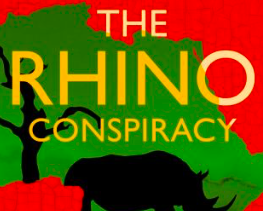Zoe Kramer reviews Peter Hain’s thriller, The Rhino Conspiracy, a novel placed at the forefront of the toxic and corrupt world of rhino poaching.
“Events have a way of finding key people who are in the right place at the right time,” the Veteran remarks.
The event? A stakeout to protect a rhino herd from poachers. The place? Zama Zama, a nature reserve in South Africa.
Once a member of MK, the armed wing of the African National Congress (ANC), the Veteran is one of The Rhino Conspiracy’s central characters. Past the age of retirement, the Veteran retains his determination to fight against corruption. His protégé, Thandi Matjeke, is a radio DJ and activist. Thandi is a born-free — meaning she was born after apartheid in Mandela’s “rainbow nation” — but she remains highly attuned to the injustices which came before her, and the ones which persist in modern life. Also at the Veteran’s side is Isaac Mkhize, a ranger at Zama Zama nature reserve who cares for the rhinos with a tactile love and tenderness.
Peter Hain’s varied cast of interwoven characters showcases the nuance of South Africa’s rhino poaching machine from a host of perspectives. The plot concerns the titular poaching conspiracy led by a group of senior government officials, and the struggle of this brave, determined few to protect the rhinos against the odds. Though The Rhino Conspiracy is a work of fiction, it draws its story from real events – giving its already considerable moral weight an increased sense of urgency.
To the Veteran and his group, the rhino attacks are not only abhorrent, but intensely personal. As Thandi puts it:
This is our heritage! Our heritage. It’s part of what makes Africa so special, so unique. Where else in the world can you find such an amazing variety of wildlife? Rhinos have been around for fifty million years. They are prehistoric. To kill them is not just criminal. It’s Armageddon!
It’s an idea which is recurrent throughout The Rhino Conspiracy, that of poaching as not just murder but a perpetuation of colonial values. In commodifying the rhino horns — sold not for any useful purpose but as quack medicine and status symbols — the poachers destroy both wildlife and their heritage. As with all colonists, the poachers are merciless and unrepentant – never considering whether they should do what they do, only charging forth to make a profit. Van der Merwe, the leader of this particular operation, embodies this mentality of exploitation. To him, his hired poachers carry as little value as the rhinos themselves – and they are subsequently sent to their death again and again; an outcome Van der Merwe views as failure, not tragedy. It’s no coincidence, of course, that Merwe is white and his hired poachers are predominantly black.
This same hierarchy echoes throughout the corrupt structures presented in The Rhino Conspiracy, adding a sense of nuance to the dubious morality displayed. While white higher-ups like Merwe generally run the show, those who are sent to commit the actual killings are often poor, black, and from villages with little opportunity. Poaching offers them a chance to build themselves up, to buy houses and cars. It is in this form that the spectre of apartheid lives on in these criminal organisations, with black poachers treated as expendable and white poachers positioned as leaders. As Issac at one point reflects: “Wildlife is seen as something for the rich, so poachers can be seen as sort of Robin Hoods. Kill a poacher and you can turn these communities against wildlife protection.”
This complex web of power and corruption complicates the Veteran’s mission to save the rhinos. He, Thandi and Issac feel disempowered by the irrevocable link between poaching and poverty, yet are faced with the need to take decisive action if the rhinos are to be saved from extinction. The fact that the Veteran’s values have remained in-tact despite many years of exposure to power is used astutely by Hain to spotlight the corruption of Moses Khoza (an underling to the President and ANC high-roller). Khoza was once imprisoned as a teenager on Robben Island along with Nelson Mandela, but has since forgone his youthful ideals and succumbed to the temptation of greed, looting the South African state and sacrificing the rhinos to line his pockets. The duality of Khoza’s rebel past and his establishment present is one of the most masterful elements of the book, with Khoza growing increasingly desperate for some kind of redemption, even as it moves further and further from his grasp.
The Rhino Conspiracy is undoubtedly a full-throttle page-turner during the poaching stakeouts, but in other moments it loses its steam when too immersed in the personal lives of its large cast of characters. At these weak points, the book’s verisimilitude is also its downfall, with the realism occasionally teetering into mundanity. Hain also has an unfortunate and inexplicable tendency of describing Thandi solely by the attraction she holds to other male characters – as well as regularly contrasting her intelligence with “other” women who are depicted as frivolous and shallow. Still, in its subject matter The Rhino Conspiracy provides considerable and detailed insight for anyone curious about the underworld of poaching and how it might be stopped.
The Rhino Conspiracy by Peter Hain is available via Muswell Press.











